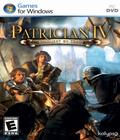It can be rough to come into a series mid-stride, especially when you are diving in to a game based around the complexities of being the head of a trading conglomerate in the old world. Patrician IV: Conquest by Trade shows off its obvious status as a long-running series with gameplay that feels very smooth and cohesive, despite it being quite deep. Instead of just dropping you on a ship and kicking you in the pants, the game holds your hand at first, gracefully starting you off with the basics and ramping up the gameplay as you get a handle on things.
Patrician IV is surprisingly deep, but you would be hard-pressed to call it that at first. Your campaign starts off with you being a grocer with one ship to your name and a few coins in your pocket. The game walks you through the basics with a helpful narrator and optional short videos that detail what you need to do to perform specific tasks. The interface is certainly complicated, but these helpful inclusions make it seem more manageable.
The overarching purpose of the game is to make money in the art of buying goods at a low price and selling them for a good profit, although there are many layers of gameplay atop that. Every city produces a set of certain goods; there are trade commodities such as wood and bricks, cheese and meat, and higher-end goods consist of clothing, grapes and spices. Since these cities produce the goods, their demand is met, thus driving down the sale price. The cities also often produce a surplus of the goods, which are snapped up by savvy traders. This means that many other trade commodities can be sold in that same city for a higher price, since demand will be high. Supply and demand is represented in more than just black and white, as some cities may not want or need more than a few tons of a particular good. This means that when you sell your 80 tons of wine, you may want to only sell 20 tons; if the demand is met, the price per ton falls through the floor.
Additionally, cities may need some goods more than others. A city that produces meat requires a lot of salt to preserve the meat; likewise, a city that produces salt will need a lot of wood to keep production going. Understanding the interconnection of trade goods can be key to making easy money as a trader, as those cities will have such high demand for some goods that it is practically impossible to meet their needs, and that desperation usually pans out into a nice and steady profit. Once you've figured out a basic trade route that capitalizes on the production and needs of a city, you are well on your way to becoming more than a tradesman with a single ship.
Gaining additional ships means that your fleet grows in cargo space and firepower, depending on which ship you get and whether or not you sacrificed cargo room for cannons. Ships take time to build, especially if the shipyard's local market lacks the cloth, pitch, wood and other goods that make ship production possible. Once built, they are geared toward pure cargo room, so you can decide whether you want to upgrade it once or twice with cannons.
Ship combat is a very basic and slightly cumbersome affair of clicking on an enemy ship to target it and then, if it's within range, firing your cannons. Both the range and the firing arc lack an on-screen indicator and must be guessed, and that can certainly get frustrating. Additionally, although you can select from three different ammo types to damage the enemy ship's hull, sails and crew, two ammo types do so little damage that it's often best to stick with the standard cannonballs and blast away at the hull.
Combat as such is an eventuality when on the high seas, especially as you increase the number of ships. As the number of vessels grows, you'll want to set up each one as its own fleet so you can automate its actions. You can set up a trade route in almost any manner you see fit, either telling the fleet to use its best judgment on buying and selling goods in specific ports or specifying that you only want to buy or sell up to a certain amount of a good and within a certain price range. This way, expanding your trade empire involves much less micromanagement, other than periodically keeping tabs on the market or as your own needs require.
Patrician IV isn't just about buying goods produced by someone else, though, as you can also produce your own. To do so, you must have a good reputation with the city and pay for the right to build inside of its walls. Then you must build production buildings and some residences for the workers. Citizens living in your homes pay you rent, and all goods created by your production buildings are stored in your warehouse to do with as you wish. You may utilize trade routes to transport them for further processing in other cities where you have operations, or you may pack them up and sell them at another port for nearly 100 percent profit.
It's about at this point that the interface begins to lack a few features that would really facilitate your budding life as a global trader. Since there isn't a way to see all trade routes at a glance, it can be tough to identify which one is visiting a set of ports or dealing with a particular good. However, you can see how much money per day a fleet is pulling in, so you'll know whether you need to tweak its trade price or eliminate the route if it's not meeting expectations.
Patrician IV presents itself well in the simplistic overworld map as well as when you are in port and can see the relatively complex array of buildings that are nestled within the city walls. The game is far from a graphical powerhouse, but it delivers almost all of the information you could need thanks to a clean and well-thought-out interface. Ship combat certainly lacks much in the way of a graphical punch, but the game is based around the successful trade of good rather than cannon fire. Through it all, the title has a certain charm that makes the gameplay seem fun despite the intricacies and complications. This is likely a bigger accomplishment than any special effects or eye candy could hope to achieve.
Patrician IV: Conquest by Trade may be all about the pursuit of fame and fortune by buying and selling goods on the high seas, but there is so much more to it. More important than the depth is how the game lets you experience it, and rather than tossing you into the deep end, it lets you get your feet wet first, turning what could be an overwhelming experience into an enjoyable one. For a game that essentially bases its entertainment value on the careful management of logistics and supply and demand, Patrician IV is excellent for those who consider themselves to be savvy traders and shrewd businessmen.
Score: 8.3/10
More articles about Patrician IV











 In Patrician IV, the player takes on the role of a young merchant in the area of the Baltic and North Sea during the late Middle Age, the zenith of the Hanseatic League and its naval trading empire.
In Patrician IV, the player takes on the role of a young merchant in the area of the Baltic and North Sea during the late Middle Age, the zenith of the Hanseatic League and its naval trading empire.
































